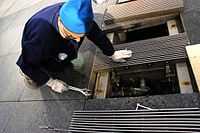Winterization

Winterization refers to the process of preparing something for an upcoming winter.
The term is often used with respect to aquatic play features, fountains, and the like, which must be drained and sealed up so that water inside does not freeze, causing breakage of the pipes in the fountain, or the like.
Winterization strategies
Some fountains, such as the Ontario Science Centre FUNtain Hydraulophone and the flame fountain in Nathan Philips Square, are designed to run year-round by virtue of heated water, whereas others require that the water be drained and that all apertures be covered to keep rainwater from entering the fountain and freezing inside.
Winterizing a summer home
Some summer homes, also known as cabins or cottages, were built for summer use only and need to be winterized each Fall. This entails locking them up, turning off water, electricity, and phone lines, and protecting various features from heavy snowfall. [citation needed]
In the New England area, many wealthy families living in cities during the 19th century had summer homes in the mountains. This was to flee the onset of yellow fever and other epidemics which often struck in the summer months, when city plumbing problems and stagnant horse manure in the streets caused a health hazard. Winterization would take place each Fall when the families returned to the cities (often when school started). In those days, winterization just referred to a lock-down of all movable parts as protection from winter storms. An example of such a summer home that needs to be winterized each fall is the scene of the movie On Golden Pond, which was filmed on Squam Lake.[citation needed]
In the 20th century, these summer mountain homes in turn were winterized to enable winter holidays, as the popularity of skiing in the mountains increased that of summer camping. In this sense, winterization refers to the addition of modern amenities such as heating and insulation, often entailing a complete rebuild of the cottage.[citation needed]
Winterization of equipment
Equipment designed for use in particularly extreme cold conditions (such as the Arctic) also undergoes a "winterization" process. Many complex devices (automobiles, electronics and radios) as well as common materials (metals, rubbers, petroleum lubricants) are not designed to operate at extremely low temperatures and must be winterized to operate without severe damage from the elements in such conditions. This might involve a chemical treatment process, additional waterproofing/insulation, or even the total substitution of new parts. An example would be the internal combustion engine of an automobile; the installation of heaters on the engine block and battery as well as the substitution of winter-grade coolants and lubricants allows the vehicle to start and run in sub-freezing conditions where a non-winterized engine would quickly break down.
Winterization of equipment can be thought of as the winter-weather extension of ruggedization.
See also
-
 Home improvement portal
Home improvement portal
External links
| Look up winterization in Wiktionary, the free dictionary. |
- Hydraulic pressure in that part of the water last to freeze
- Pool and Sprinkler Systems Winterization information
- Boat winterizing information